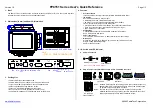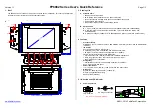
Appendix B: Wireless Technology
134
MVP-5200i Modero® ViewPoint® Touch Panel with Intercom - Instruction Manual
Appendix B: Wireless Technology
Overview of Wireless Technology
802.11b/2.4 GHz and 802.11a/5 GHz
are the two major WLAN standards and both operate using radio frequency (RF)
technology. Together the two standards are together called Wi-Fi and operate in frequency bands of 2.4 GHz and 5 GHz
respectively.
The
802.11b
specification was the first to be finalized and reach the marketplace. The actual throughput obtained from
an 802.11b network will typically be between 4 and 5 Mbps.
Because of the higher frequency (and thus shorter wavelength) that they use,
802.11a
signals have a much tougher time
penetrating solid objects like walls, floors, and ceilings. As a result, the price for 802.11a's higher speed is not only a
shorter range but also a weaker and less consistent signal.
802.11g
provides increased bandwidth at 54 Mbps. As part of the IEEE 802.11g specification, when throughput cannot be
maintained, this card will automatically switch algorithms in order to maintain the highest spread possible at a given
distance. In addition, 802.11g can also step down to utilize 802.11b algorithms and also maintain a connection at longer
distances.
IP Routing
is a behavior of the wireless routing is largely dependent on the wired network interface. Although the panel can
be connected to two networks simultaneously, it may only have one gateway. If the wired network was successfully set up
and a gateway was obtained; then the default route for all network traffic will be via the wired network. In the event that the
wired network was not configured, then the default route for all network traffic will be via the wireless network. The wired
network connection always takes priority.
Example
: Imagine a panel connected to the two networks A & B. A is the wired network and B is the wireless network. If the
Master controller is on either of these networks, then it will be reached. However if the Master controller is on a different
network, C, then the gateway determines which network interface (wired or wireless) will be used.
Access Points (APs)
are the cornerstone of any wireless network. A AP acts as a bridge between a wired and wireless
network. It aggregates the traffic from all wireless clients and forwards it down the network to the switch or router. One AP
may be all that is necessary for a standard installation. However, more APs may be needed, depending on the size of the
installation, its layout, and its construction.
Wireless Equivalent Privacy
(
WEP
) Security is a method by which WLANs protect wireless data streams. A data stream
encrypted with WEP can still be intercepted or eavesdropped upon, but the encryption makes the data unintelligible to the
interloper. The strength of WEP is measured by the length of the key used to encrypt the data. The longer the key, the
harder it is to crack.
802.11b implementations provided 64-bit and 128-bit WEP keys. This is known respectively as 64-bit and 128-bit WEP
encryption. 64-bit is generally not regarded as adequate security protection. Both key lengths are supported by the
Modero product line.
Whichever level of WEP used,
using identical settings is crucial (CASE SENSITIVE)
--the key length, and the key itself-- on
all devices. Only devices with common WEP settings will be able to communicate. Similarly, if one device has WEP enabled
and another does no, they will not be able to talk to each other.
Although the calculations required to encrypt data with WEP can impact the performance of your wireless network, this
impact is generally only seen when running benchmarks, and is not large enough to be noticeable in the course of normal
network usage.









































